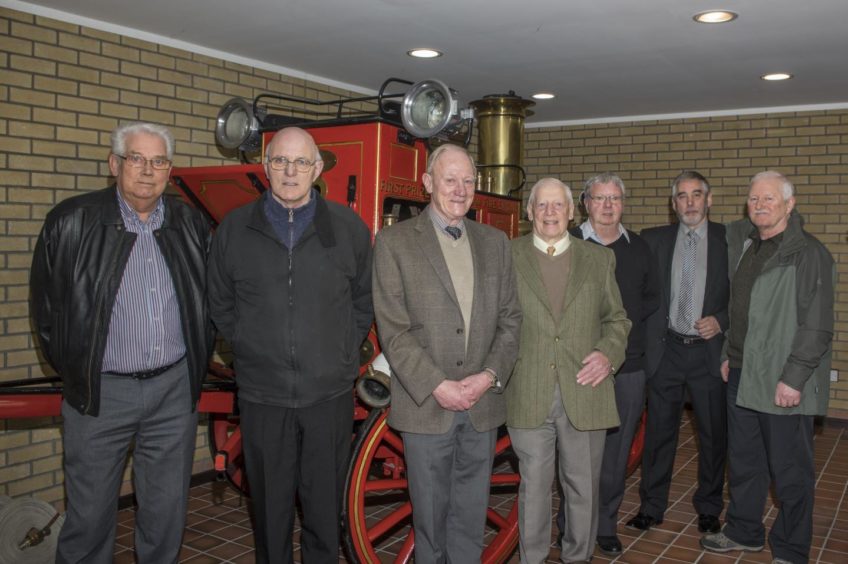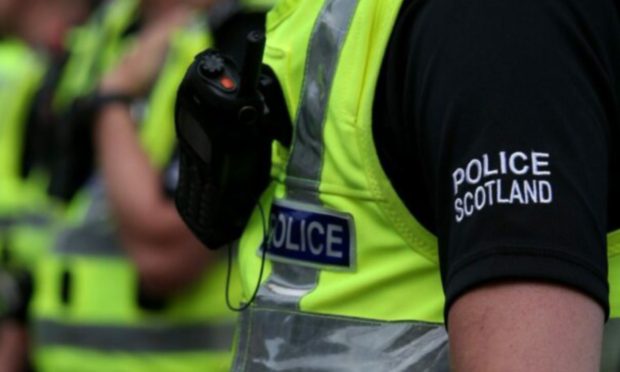Michael Alexander finds out about the painstaking restoration of an original late 1800s horse drawn Shand Mason steam fire engine that now sits proudly on permanent display in Forfar Fire Station.
When The Courier’s Craigie column published a picture recently of a Volvo FL6 fire engine at Arbroath in April 1991, it was a flashback to the then state of the art equipment being used by Tayside firefighters.
But it also rekindled memories of an ambitious restoration project going on around the same time that saw Angus firefighters painstakingly restore a piece of history.
Four of the five crew in the photograph with the then new Arbroath appliance were heavily involved in restoring an original late 1800s horse drawn steam fire engine.
The restored Shand Mason Steam Fire Engine No.605 now sits proudly on display in Forfar Fire Station and is a credit to the Tayside crews that undertook the task.
How the Shand Mason restoration project began
Retired Tayside firefighter Alan Rae, formerly of Blue Watch – Station A4, Arbroath – will never forget how he and fellow crew rediscovered the vintage piece of equipment and secured permission to do it up.
Alan, an ex-Royal Marine, had been involved in planning celebrations in 1989 that marked 30 years since Arbroath Fire Station opened and 25 years since crews went whole-time/retained.
After attending the Glamis Vintage Vehicle Extravaganza that year where he saw Dennis Scott from Grampian Fire Brigade parade round the arena with his horse-drawn Shand Mason, Alan mentioned to colleagues that prior to joining the fire brigade in 1978, he had worked in Don & Low Ltd’s Canmore Works in Forfar and had spotted an old ‘steamer’ in the factory there.
The machine was behind a stud-partitioned wall and the brass helmets were still there along with the axes.
Don & Low’s predecessors Don Brothers originally bought the engine to help protect their textile operations in Forfar, in the event of them having an outbreak of fire in one of their factories.
After the engine became obsolete, it wasn’t disposed of, and lay hidden away for years.
After some discussion, Alan and his colleagues decided they should approach Dons to see if they could get access to their ‘fire engine’ with a view to restoring it.
By this time they had formed a Vintage Section at Arbroath Fire Station with support from people from other stations.
Alan and close firefighter buddy Bruce Peters met with and outlined their restoration plans to David Petrie, one of the Don & Low directors.
Without hesitation, Mr Petrie said they could have it on permanent loan – the only stipulation being that they attach a brass plaque to the appliance stating that it belonged to Don & Low Ltd of Forfar.
With a permanent display area secured as part of plans for a new Forfar Fire Station, the Shand Mason was delivered to Arbroath Fire Station in May 1991 by one of Don & Low’s lorries.
Dennis Scott, from Grampian Fire Brigade, also came down to pass on some of his experience about restoration. Then the real fun began.
The restoration work
“Once we began to remove the black paint from the pipe-work and other metalled areas we discovered beautiful copper and brass pipes and joints,” recalls Alan.
“It was a joy to see this black paint being stripped away to reveal the Shand Mason’s true beauty.
“What it did give us was more work, because all this metal had to be polished and buffed on a regular basis.
“Fortunately we had people within the team who carried out this laborious task, me being one of them.”
Alan recalls that with the wooden wheels beginning to dry out, the spokes were beginning to come away from the wooden rim.
They acquired substantial axle stands on which to rest the machine while they took the wheels off.
This job was undertaken by Sub Officer Stuart Miller of Arbroath’s Red Watch.
He often helped out at Riddler’s Bus Company and was used to the intricacies of removing wheels from vehicles.
It wasn’t always without incident, however.
“As I watched him take a hammer to the hub of one of the large wheels my concern grew, especially as the hammers got larger and the blows more powerful,” recalls Alan.
“I was saying to myself, ‘Please be careful Stuart,’ or words to that effect.
“Eventually he had the four wheels removed, and without any damage to them.
“We built portable dams at the rear of the station and placed the wheels in the water to swell them again. Unfortunately, during this process the decorative gold leaf circling the wheels floated off.”
Hard-working fire service team
Team members included Sub Officer Pete Sinclair, who was a keen motor enthusiast; Fireman Bruce Peters, who could turn his hand to anything from metal-work to joinery; Fireman Jim Forbes, a plumber by trade; Fireman Fred Cook, who was a dab hand with a hammer; Fireman Ewan McIntosh who was also a labourer and a great polisher of metal, and then Alan himself who describes his role as “more of a labourer and handy man”.

From time-to-time, other firefighters from the station, including the retained men, would drop in to see if they could give a hand.
Other talented and skilful people who got involved included Fireman Ron Milne, from Dundee, who volunteered to re-do the gold leaf trim on all the wheels, paid for out of his own pocket.
The aim was to have the Shand Mason completed in time to enter it into the Dundee Pageant which was taking place in June 1991.
Dennis Scott had offered to lend some period helmets, tunics, white lanyards and gloves along with any other pieces of equipment required.
Alan also contacted the Heavy Horse Centre at Walnut Grove, Perth and arranged for two of their large horses and a driver to come to Blackness Road Fire Station, Dundee.
“On the day of the pageant all was ready,” recalls Alan.
“The Steamer’s metalwork was sparking in the bright sunshine.
“The white lengths of suction hose were immaculate and the crew were dressed in their shiny brass helmets, tunics and polished leather boots.
“The horses were hitched up and we all assembled in the first machine bay of Blackness Road Fire Station.
“The doors opened, cameras rolled and pictures taken as the horses eventually found their footing and we emerged from the confines of the station and made our way to where the convoy of floats were forming up.
“As we paraded through the streets of Dundee the route was crowded with thousands of onlookers all trying to catch a glimpse of the many floats and performers taking part.
“We had bought smoke pellets which we lit and dropped into the chimney of the Steamer.
“Once the smoke was produced we could hardly see the crowd at times as the smoke produced was so dense.
“Then all too soon the parade was over and we made our way back to Blackness Road Fire Station.
“The poor horses began to struggle as they made their way up the hill from the city centre so we all disembarked, except the driver to make it easier for them to climb the hill.”
Popular with the public
One of the other outings they did with the appliance was Dundee’s Expo 800 exhibition which was staged along Riverside Drive. The exhibition celebrated many of the city’s manufacturing and support industries.
The next call of duty was to the Glamis Vintage Vehicle Extravaganza held in the grounds of Glamis Castle in July 1991. The last event they took the Steamer to was the Cortachy Highland Games.
Later, the livery was refurbished by guests at HM open prison at Castle Huntly, near Dundee.
When the appliance arrived back at Blackness Road, the final stage of the restoration was undertaken and the livery she still carries today was expertly applied by fire personnel.
The appliance has resided safely in a purpose built bay within Forfar Fire Station since.
A job well done
In 2016, the 25th anniversary of the restoration was celebrated with an informal get–together at Forfar, organised by Dave Farries who has heritage responsibilities within the Scottish Fire and Rescue Service, and Keith Richardson who is a former colleague of Dave and a volunteer with the service’s National Museum in Edinburgh.
They also invited two guests of honour: David Petrie who had been one of the directors at Don & Low and had given the go-ahead on behalf of the company, and secondly, Alistair Hay who was at that time the Chief Officer of Scottish Fire and Rescue.
Alistair was ex-Tayside Fire Brigade and had been a station commander at Arbroath during his earlier service years and knew most, if not all the guys involved with the restoration.
Reflecting on the project, Keith says it’s a lesson in foresight, persuasion, co-operation, teamwork and determination, if ever there was one.

















